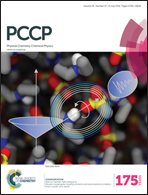Formation of simple nitrogen hydrides NH and NH2 at cryogenic temperatures through N + NH3 → NH + NH2 reaction: dark cloud chemistry of nitrogen
Abstract
Although NH3 molecules interacting with ground state nitrogen atoms N(4S) seem not to be a very reactive system without providing additional energy to initiate the chemical process, we show through this study that, in the solid phase, at very low temperature, NH3 + N(4S) reaction leads to the formation of the amidogen radical NH2. Such a dissociation reaction previously thought to occur exclusively through UV photon or energetic particle irradiation is in this work readily occurring just by stimulating the mobility of N(4S)-atoms in the 3–10 K temperature range in the solid sample. The N(4S)–N(4S) recombination may be the source of metastable molecular nitrogen N2(A), a reactive species which might trigger the NH3 dissociation or react with ground state nitrogen atoms N(4S) to form excited nitrogen atoms N(4P/2D) through energy transfer processes. Based on our obtained results, it is possible to propose reaction pathways to explain the NH2 radical formation which is the first step in the activation of stable species such as NH3, a chemical induction process that, in addition to playing an important role in the origin of molecular complexity in interstellar space, is known to require external energy supplies to occur in the gas phase.


 Please wait while we load your content...
Please wait while we load your content...